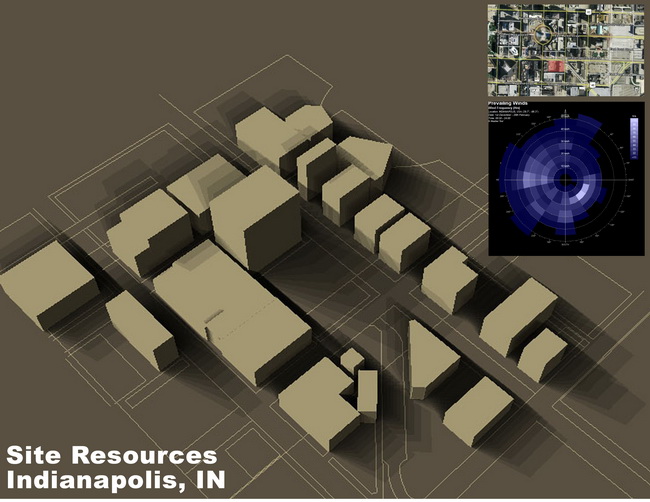Graduate and Undergraduate Seminar Course
Intermediate and Senior Students
Site Analysis

Design Performance Objective |
Site Analysis
The image shows a shadow range analysis of the project site. The analysis aims to identify the parts of the site with/without the availability of solar resources. The analysis aims to provide guidance for the studio students in identifying the best location for their project on the site The wind rose also indicates the prevailing wind directions which, combined with the surrounding buildings, can indicate the potential for summer natural ventilation or protection from cold winter winds as needed.
|
Student: Anish Joseph |
| Software / Tools: |
Ecotect |
|
Spring 2008 “Applications in Sustainable Design” Graduate/ Undergraduate Seminar
Site Analysis
1. To identify the resource potentials/limitations of the selected site/climate in terms of solar, wind, and other natural resources.
2. To determine the parts of the selected site which provide the most potential for taking advantage of these resources (taking into consideration site characteristics and surrounding buildings).
• course and project outline
|
Investigative Strategy |
1. Build a model of the site in ECOTECT including all surrounding buildings and/or natural features.
2. Using ECOTECT, simulate the shadow range, solar access, and wind potential of the site for important times of the year.
|
Evaluation Process |
|
Students were required to submit a report describing the analysis process and conclusions with regard to the potential/limitations of their selected sites. Conclusions for each site were evaluated by the instructor and discussed in class.
|
Evaluative Criteria |
Students were evaluated based on the accuracy of the resource analysis with regard to the different natural resources and conditions of the selected site as well as the depth of their resulting design guidance, communicated to the studio students.
|
Cautions - Possible Confusions |
None.
|
Range of Applicability in terms of CLIMATE |
ALL |
Range of Applicability in terms of TYPE |
ALL |
Reference Material |
Brown, G. Z. and Dekay, M. 2000. Sun, Wind & Light: Architectural Design Strategies, 2nd Edition. New York, NY: John Wiley & Sons.
Kwok, A. and Grondzik, W. 2007. Green Studio Handbook, Environmental Strategies for Schematic Design. Oxford, UK: Architectural Press.
Lechner, N., 2001. Heating, Cooling, Lighting: Design Methods for Architects. 2nd Edition. New York, NY: John Wiley & Sons.
Autodesk, 2009, Autodesk ECOTECT Wiki, available online at: http://squ1.org/front_page
|
Duration of Exercise |
The task represented the first part of a larger assignment with an overall duration of two weeks. The model used in this task was also used for the remainder of the assignment (which will be discussed in the next topic). |
Degree of Difficulty / Previous Knowledge Required |
The assignment has a low to medium degree of difficulty depending on the student’s prior experience with digital modeling. Much of the difficulty lies in developing the site model, including site topography and surrounding buildings. Only basic/mass models are needed for those buildings.
Before working on this assignment, students were introduced to the modeling tool used (ECOTECT) over a period of 3-4 weeks, in which the different capabilities of the tool were illustrated in class and applied by the students to several independent exercises.
|
|
|
|

